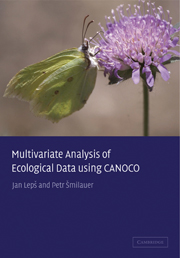Book contents
- Frontmatter
- Contents
- Preface
- 1 Introduction and data manipulation
- 2 Experimental design
- 3 Basics of gradient analysis
- 4 Using the Canoco for Windows 4.5 package
- 5 Constrained ordination and permutation tests
- 6 Similarity measures
- 7 Classification methods
- 8 Regression methods
- 9 Advanced use of ordination
- 10 Visualizing multivariate data
- 11 Case study 1: Variation in forest bird assemblages
- 12 Case study 2: Search for community composition patterns and their environmental correlates: vegetation of spring meadows
- 13 Case study 3: Separating the effects of explanatory variables
- 14 Case study 4: Evaluation of experiments in randomized complete blocks
- 15 Case study 5: Analysis of repeated observations of species composition from a factorial experiment
- 16 Case study 6: Hierarchical analysis of crayfish community variation
- 17 Case study 7: Differentiating two species and their hybrids with discriminant analysis
- Appendix A Sample datasets and projects
- Appendix B Vocabulary
- Appendix C Overview of available software
- References
- Index
1 - Introduction and data manipulation
Published online by Cambridge University Press: 09 February 2010
- Frontmatter
- Contents
- Preface
- 1 Introduction and data manipulation
- 2 Experimental design
- 3 Basics of gradient analysis
- 4 Using the Canoco for Windows 4.5 package
- 5 Constrained ordination and permutation tests
- 6 Similarity measures
- 7 Classification methods
- 8 Regression methods
- 9 Advanced use of ordination
- 10 Visualizing multivariate data
- 11 Case study 1: Variation in forest bird assemblages
- 12 Case study 2: Search for community composition patterns and their environmental correlates: vegetation of spring meadows
- 13 Case study 3: Separating the effects of explanatory variables
- 14 Case study 4: Evaluation of experiments in randomized complete blocks
- 15 Case study 5: Analysis of repeated observations of species composition from a factorial experiment
- 16 Case study 6: Hierarchical analysis of crayfish community variation
- 17 Case study 7: Differentiating two species and their hybrids with discriminant analysis
- Appendix A Sample datasets and projects
- Appendix B Vocabulary
- Appendix C Overview of available software
- References
- Index
Summary
Why ordination?
When we investigate variation of plant or animal communities across a range of different environmental conditions, we usually find not only large differences in species composition of the studied communities, but also a certain consistency or predictability of this variation. For example, if we look at the variation of grassland vegetation in a landscape and describe the plant community composition using vegetation samples, then the individual samples can be usually ordered along one, two or three imaginary axes. The change in the vegetation composition is often small as we move our focus from one sample to those nearby on such a hypothetical axis.
This gradual change in the community composition can often be related to differing, but partially overlapping demands of individual species for environmental factors such as the average soil moisture, its fluctuations throughout the season, the ability of species to compete with other ones for the available nutrients and light, etc. If the axes along which we originally ordered the samples can be identified with a particular environmental factor (such as moisture or richness of soil nutrients), we can call them a soil moisture gradient, a nutrient availability gradient, etc. Occasionally, such gradients can be identified in a real landscape, e.g. as a spatial gradient along a slope from a riverbank, with gradually decreasing soil moisture. But more often we can identify such axes along which the plant or animal communities vary in a more or less smooth, predictable way, yet we cannot find them in nature as a visible spatial gradient and neither can we identify them uniquely with a particular measurable environmental factor. In such cases, we speak about gradients of species composition change.
- Type
- Chapter
- Information
- Publisher: Cambridge University PressPrint publication year: 2003
- 5
- Cited by



